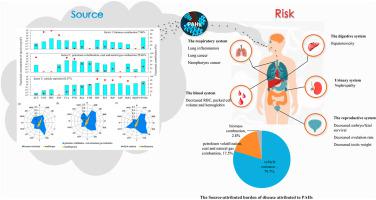Atmospheric Environment ( IF 4.2 ) Pub Date : 2021-01-09 , DOI: 10.1016/j.atmosenv.2021.118202 Yanjiao Chen , Jianwei Liu , Hongbin Cao , Aichen Zhang , Anqi Zhou , Xu Zhou

|
Polycyclic aromatic hydrocarbons (PAHs) are the main toxic components bound to PM2.5 that have carcinogenic, teratogenic and mutagenic toxicity. Priority control sources were determined by integrating source apportionment with a comparative health risk index of disability adjusted life years (DALYs). The positive matrix factorization (PMF) method was applied to 255 daily PM2.5-bound PAH concentrations detected during 2017 in urban Beijing. Three sources and mass contributions were determined: vehicle emissions (62.6%); coal and natural gas combustion and petroleum volatilization (29.5%); and biomass combustion (8.0%). The conditional probability function (CPF) analysis of the three sources revealed that the near-distance potential source direction was southeast of Beijing. The higher ratio of (3 + 4) ring PAHs/(5 + 6) ring PAHs in the summer implied a longer transport distance of PAHs and a larger emission region for the summer than for the other three seasons. The source-attributed DALYs were estimated based on the source mass contribution from PMF, the inhalation unit risk of PAHs for each disease and the individual DALYs for each disease. The total burden of some typical diseases attributable to PM2.5-bound PAHs was 923.44 DALYs/year, or 6.82 × 10−5 DALYs/person/year. Among these diseases, the carcinogenic effect imposed the greatest burden, accounting for 99.6% of the total burden of disease (upper respiratory cancer accounted for 16.0% and tracheal, bronchial and lung cancer accounted for 83.6%). Although the order of sources by disease burden was identical to that by mass contribution, vehicle emissions contributed a much larger disease burden (79.7%) and thus should be reduced further. The DALYs index breaks the barrier between noncarcinogenic and carcinogenic risk assessments. This enables comparison of the disease burden among different regions and pollutants and is thus helpful for source control and risk management.











































 京公网安备 11010802027423号
京公网安备 11010802027423号